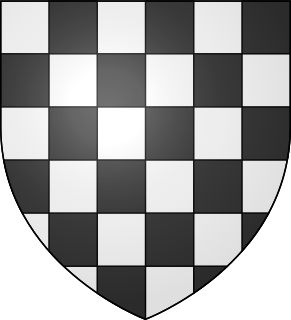
Guinevere, often written as Guenevere or Guenever, is the wife and queen of King Arthur in the Arthurian legend. Guinevere has been portrayed as everything from a villainous and opportunistic traitor to a fatally flawed but noble and virtuous lady. She has first appeared in Geoffrey of Monmouth's Historia Regum Britanniae, a pseudo-historical chronicle of British history written in the early 12th century, and continues to be a popular character in the modern adaptations of the legend.
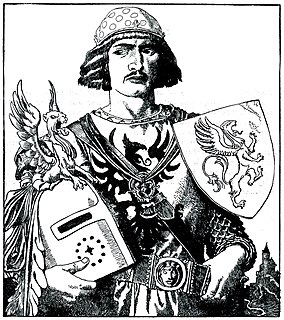
Gawain, also known as Gawaine or Gauwaine, among various other forms and spellings, is King Arthur's nephew and a Knight of the Round Table in the Arthurian legend. Under the name Gwalchmei, he appears very early in the legend's development, being mentioned in some of the earliest Welsh Arthurian sources. As Gawain, he appears in Latin, French, English, Dutch, German and Italian literature, notably as the protagonist of the story of Sir Gawain and the Green Knight. Other tales of Gawain include Historia Regum Britanniae, Roman de Brut, De Ortu Waluuanii, Diu Crône, The Awntyrs off Arthure, Le Chevalier à l'épée, and The Weddynge of Syr Gawen and Dame Ragnell, as well as the works of Chrétien de Troyes and the prose cycle Lancelot-Grail.

Sir Lancelot du Lac, alternatively also written as Launcelot and other spellings, is one of the Knights of the Round Table in the Arthurian legend. He typically features as King Arthur's greatest companion, the lord of Joyous Gard and the greatest swordsman and jouster of the age – until his adulterous affair with Queen Guinevere is discovered, causing a civil war which was exploited by Mordred and brings about the end of Arthur's kingdom.

Mordred or Modred is a character who is variously portrayed in the Arthurian legend. The earliest known mention of a possibly historical Medraut is in the Welsh chronicle Annales Cambriae, wherein he and Arthur are ambiguously associated with the Battle of Camlann in a brief entry for the year 537. His figure seemed to have been regarded positively in the Welsh tradition and may have been related to that of Arthur's son.

Sir Galahad among other versions of his name, is a knight of King Arthur's Round Table and one of the three achievers of the Holy Grail in Arthurian legend. He is the illegitimate son of Sir Lancelot and Elaine of Corbenic, and is renowned for his gallantry and purity as the most perfect of all knights. Emerging quite late in the medieval Arthurian tradition, Sir Galahad first appears in the Lancelot–Grail cycle, and his story is taken up in later works such as the Post-Vulgate Cycle and Sir Thomas Malory's Le Morte d'Arthur. His name should not be mistaken with Galehaut, a different knight from Arthurian legend.

Morgan le Fay, alternatively known as Morgan(n)a, Morgain(e), Morg(a)ne, Morgant(e), Morgen, and Morgue(in) among other names and spellings, is a powerful enchantress in the Arthurian legend. Early appearances of Morgan do not elaborate her character beyond her role as a goddess, a fay, a witch, or a sorceress, generally benevolent and related to King Arthur as his magical savior and protector. Her prominence increased over time, as did her moral ambivalence, and in some texts there is an evolutionary transformation of her to an antagonist, particularly as portrayed in cyclical prose such as the Lancelot-Grail and the Post-Vulgate Cycle. A significant aspect in many of Morgan's medieval and later iterations is the unpredictable duality of her nature, with potential for both good and evil.

Le Morte d'Arthur is a reworking by Sir Thomas Malory of existing tales about the legendary King Arthur, Guinevere, Lancelot, Merlin, and the Knights of the Round Table. Malory interpreted existing French and English stories about these figures and adds original material. Malory's actual title for the work was The Whole Book of King Arthur and His Noble Knights of the Round Table, but after Malory's death the publisher changed the title to that commonly known today, which originally only referred to the final volume of the work.

Sir Gareth [ˈɡarɛθ] is a Knight of the Round Table in Arthurian legend, nicknamed "Beaumains" in Le Morte d'Arthur. He was the youngest son of King Lot and Morgause, King Arthur's half-sister, thus making him Arthur's nephew, as well as brother to Gawain, Agravain, and Gaheris, and either a brother or half-brother of Mordred.
Gaheris or Gaheries is a character in the Arthurian legend, a nephew of King Arthur and a knight of the Round Table, the third son of Arthur's sister or half-sister Morgause and her husband Lot, King of Orkney and Lothian. He is the younger brother of Gawain and Agravain, and the older brother of Gareth and half-brother of Mordred. Gaheris is little more than a supporting character to Gawain and Gareth in Le Morte d'Arthur, with the murder of Morgause an odd exception. Gaheris and Gareth are both killed by Lancelot during his rescue of Guinevere.
Sir Agravain is a Knight of the Round Table in Arthurian legend. In Chrétien de Troyes, the Vulgate and Post-Vulgate cycles and in Thomas Malory's Le Morte d'Arthur, he is the second eldest son of King Lot of Orkney with Anna/Morgause, thus nephew of King Arthur, and brother to Sir Gawain, Gaheris, and Gareth, and half-brother to Mordred. Agravain secretly makes attempts on the life of his hated brother Gaheris and participates in the slayings of Lamorak and Palamedes in the Post-Vulgate tradition, and murders Dinadan in the Prose Tristan. Together with Merlin, he plays a leading role by exposing his aunt Guinevere's affair with Lancelot, which leads to his death at the hands of Lancelot.
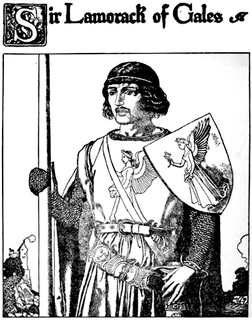
Sir Lamorak is a Knight of the Round Table in Arthurian legend, a son of King Pellinore and brother of Percival, Tor, Aglovale, and sometimes the Grail maiden Dindrane and others. Introduced in the Prose Tristan, Lamorak reappears in later works including the Post-Vulgate Cycle and Sir Thomas Malory's Le Morte d'Arthur. Malory refers to him as Arthur's third best knight, only inferior to Lancelot and Tristan, but Lamorak was not exceptionally popular in the romance tradition, confined to the cyclical material, subordinate to more prominent characters.
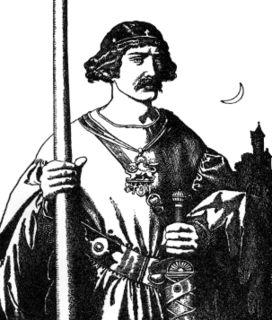
Sir Yvain, also known as Ywain, Owain, Uwain(e), Ewaine, etc., is a knight of the Round Table in Arthurian legend, wherein he is often the son of King Urien of Gorre and the sorceress Morgan le Fay. The historical Owain mab Urien, on whom the literary character is based, was the king of Rheged in Great Britain during the late 6th century.
The Post-Vulgate Cycle, also known as the Roman du Graal, is one of the major Old French prose cycles of Arthurian literature. It is essentially a rewriting of the earlier Vulgate Cycle, with much left out and much added, including characters and scenes from the Prose Tristan.

Sir Dinadan is a Knight of the Round Table in the Arthurian legend's chivalric romance tradition. He is the son of Sir Brunor senior, a brother of Sirs Breunor le Noir and Daniel, and a close friend of Sir Tristan.
The Prose Tristan is an adaptation of the Tristan and Iseult story into a long prose romance, and the first to tie the subject entirely into the arc of the Arthurian legend. It was also the first major Arthurian prose cycle commenced after the widely popular Lancelot-Grail, which influenced especially the later portions of the Prose Tristan.
Sir Sagramore is a Knight of the Round Table in the Arthurian legend.
Bagdemagus (pronounced /ˈbægdɛˌmægəs/) is a character in the Arthurian legend, normally depicted as king of the land of Gorre and a Knight of the Round Table. He chiefly figures in literature the father of the knight Maleagant, who abducts King Arthur's wife Queen Guinevere in several versions of a popular episode. Bagdemagus first appears in Old French sources, but the character may have developed out of the earlier Welsh traditions of Guinevere's abduction, an evolution suggested by the distinctively otherworldly portrayal of his realm. In most versions he is portrayed as a kinsman and ally of Arthur and a wise and virtuous king, despite the actions of his son.
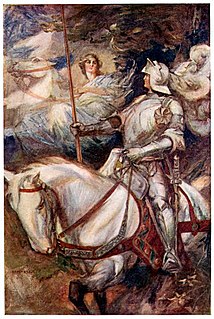
Guiomar is the best known name of a character appearing in many medieval texts relating to the Arthurian legend, often in relationship with Morgan le Fay or a similar fairy queen type character.

